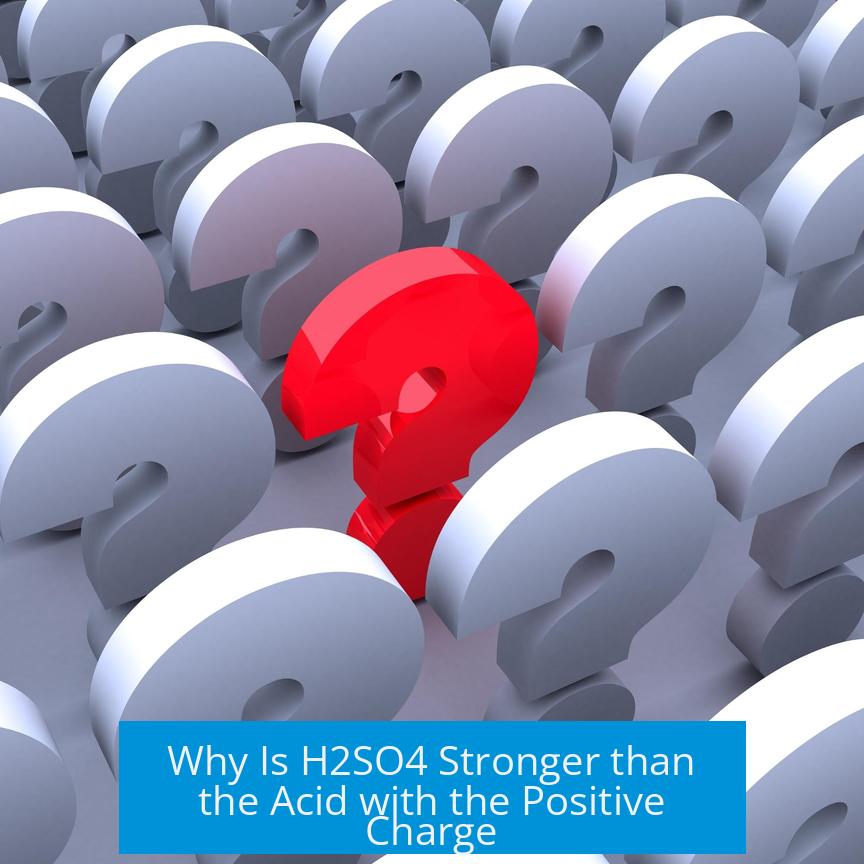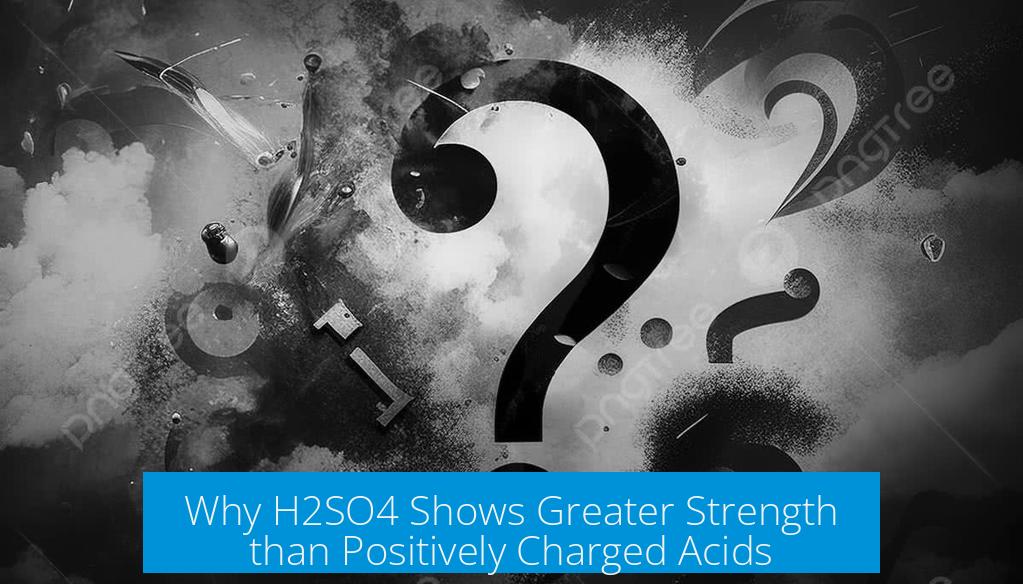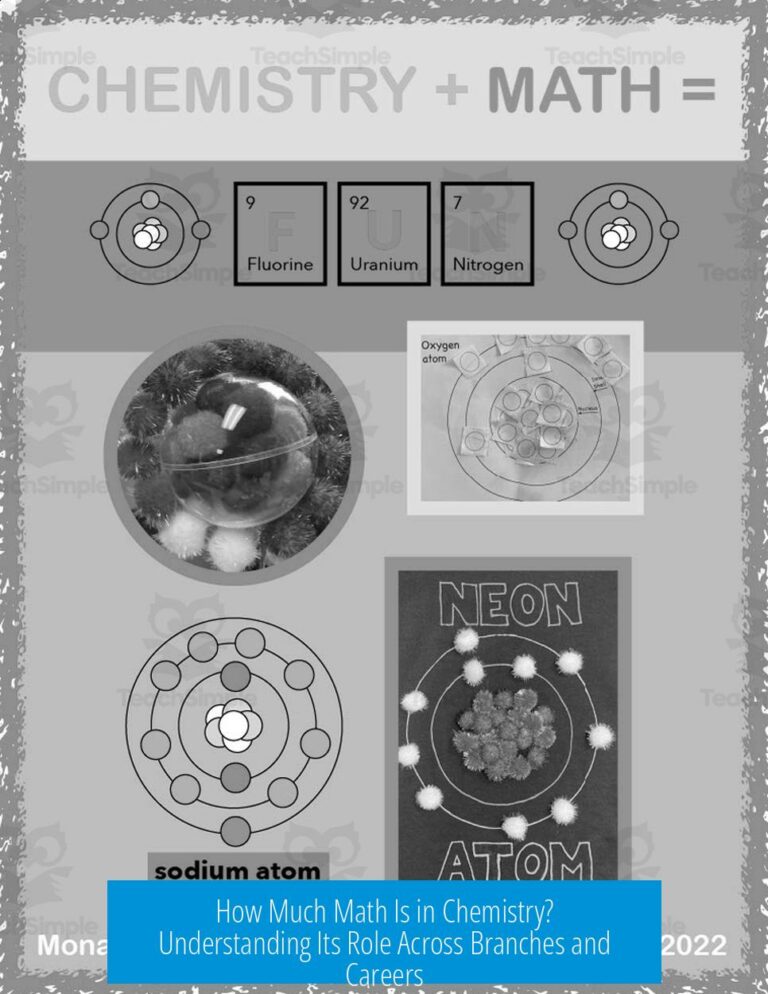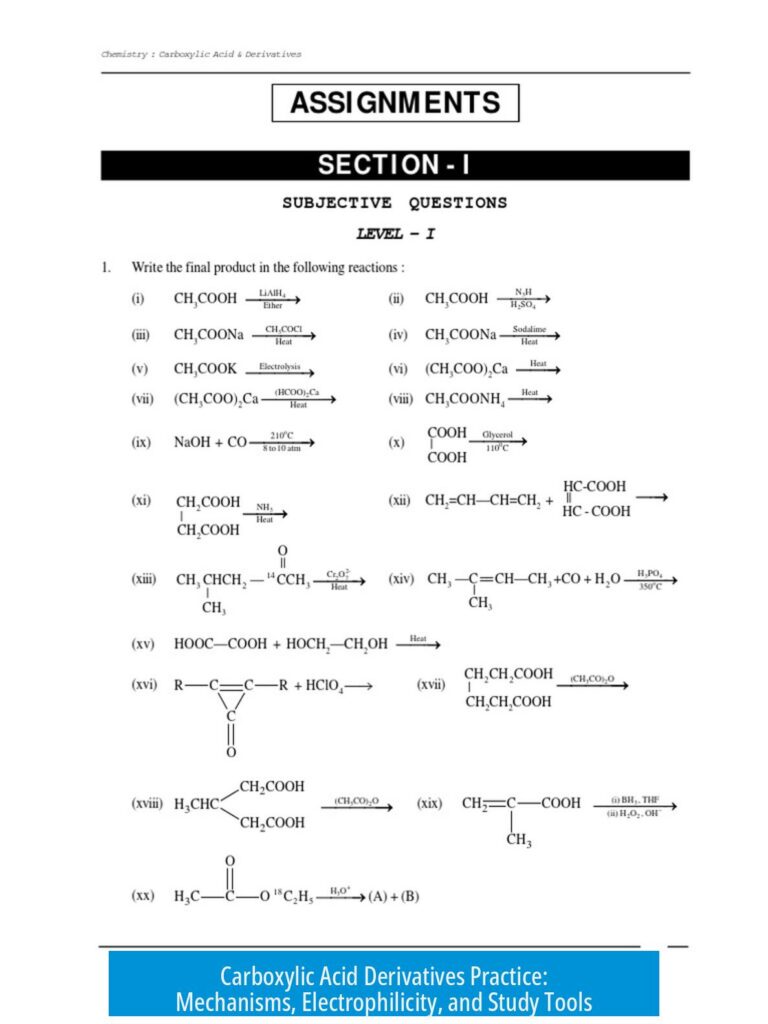Why Is H2SO4 Stronger than the Acid with the Positive Charge?

H2SO4 (sulfuric acid) is stronger than the acid with a positive charge because its conjugate base (HSO4-) is highly stabilized by extensive resonance and charge delocalization. This stabilization lowers the energy required to lose a proton, making H2SO4 a more efficient proton donor despite the existence of some positively charged acids.
Structural and Electronic Influences on Acid Strength

Both acids involve a proton attached to an oxygen atom. The key difference lies beyond this: sulfur dioxide’s large, electronegative environment versus smaller alkyl groups in the other acid.
- In sulfuric acid, the central sulfur atom is bonded to multiple oxygen atoms.
- These oxygen atoms are highly electronegative and capable of withdrawing electron density.
- The bulk of the sulfur and the surrounding oxygens creates a bulky but strongly electron-withdrawing environment.
- In contrast, acids with positive charge on oxygen but centered on smaller groups such as alkyl- or hydrogen-substituted structures have less electron withdrawal.
Thus, the sulfur-oxygen environment in sulfuric acid greatly weakens the O–H bond, making proton release easier.

Charge Distribution and Resonance Stabilization of the Conjugate Base
The strength of an acid is inversely related to the stability of its conjugate base. HSO4-, the conjugate base of H2SO4, is exceptionally stable.

- HSO4- has multiple resonance structures that delocalize the negative charge across four oxygen atoms.
- This delocalization makes it like the “benzene of anions” for its charge stability.
- This extensive resonance prevents localized charge build-up, lowering the energy of the conjugate base.
- By contrast, a positively charged acid (for example, an ethyloxonium ion) has less effective charge distribution.
Effective resonance stabilization of HSO4- significantly contributes to sulfuric acid’s greater acidity compared to acids with positive oxygen centers.
Comparison of pKa Values and Acid Strength

| Acid | pKa | Relative Strength |
|---|---|---|
| H2SO4 | -10 (first proton) | Very strong acid |
| Ethyloxonium ion (protonated ethanol) | ~ -3 | Weaker acid |
| Bisulfate ion (HSO4-) | ~ 2 | Weak acid |
The equilibrium in acid-base reactions favors the formation of the weaker acid and base. Since sulfuric acid has the lowest pKa, it is the strongest proton donor, pushing equilibrium toward protonated alcohol species.
Mechanistic Insight: Bond Strength and Electron Effects
Sulfuric acid’s O–H bonds are uniquely weakened by electronic factors.
- Electrons from the O–H bond are pushed toward the O–S bond, creating a very unstable O–H bond.
- This destabilization makes proton release highly favorable.
- In contrast, the positive oxygen in ethyloxonium and similar species has a comparatively stronger O–H bond, limiting its acid strength.
Consequently, sulfuric acid’s structure enhances its acidity through bond weakening and charge effects.
The Diprotic Nature of Sulfuric Acid and Analogy to Water
Sulfuric acid is diprotic, meaning it can lose two protons sequentially.
- The first proton dissociation is extremely strong.
- The second dissociation is weaker but still contributes to the overall acidity.
- The acid’s behavior is analogous to water becoming hydronium (H3O+), where protonation adds a positive charge but stabilizes the species.
- Protonated alcohols (oxonium ions) resemble hydronium, but sulfuric acid’s ability to fully dissociate produces stronger acidic conditions.
This diprotic feature helps explain why sulfuric acid can surpass positively charged acids in strength.
Energetic Favorability and Equilibrium Position
The proton transfer from sulfuric acid to other species is energetically downhill.
- Though protonated ethanol is less stable, the formation of hydrogen sulfate (HSO4-) compensates energetically.
- The conjugate base’s stability outweighs the energy cost of protonation in the other acid.
- HSO4- itself can act as a weak acid but will not revert to a base easily due to its resonance stabilization.
Equilibrium thus favors proton donation by sulfuric acid, reinforcing its classification as the stronger acid.
Key Takeaways
- Extensive resonance stabilization of HSO4- results in a very stable conjugate base.
- Electron-withdrawing sulfur and surrounding oxygens weaken O–H bonds in H2SO4, facilitating proton loss.
- Lower pKa values for H2SO4 indicate its superior acidity compared to positively charged acids like ethyloxonium ions.
- Diprotic nature and analogy to hydronium explain sulfuric acid’s ability to donate protons more readily.
- Energetic favorability of equilibrium supports sulfuric acid acting as a stronger proton donor in solution.
Why Is H2SO4 Stronger Than the Acid with the Positive Charge?
In short, H2SO4 wins the acidity race because it sports a super stabilized conjugate base—thanks to clever charge delocalization and resonance—making proton donation smoother and energetically favored over an acid with a positive charge. Let’s unravel the science behind this and see why sulfuric acid packs such a punch compared to a positively charged acid like the ethyloxonium ion.
Structural and Electronic Factors: Who’s Backing the Proton?
Imagine two acids each clutching a proton attached to an oxygen atom. One is sulfuric acid (H2SO4), the other is a positive ion derived from ethanol (think ethyloxonium). What’s really going on behind the scenes? The key lies beyond just that proton-O bond.
On one side, sulfuric acid features a sulfur atom surrounded by several oxygens. This ensemble is pretty bulky and, importantly, charge withdrawing. Why does that matter? Because withdrawing electrons stabilizes the conjugate base by spreading the negative charge.
In contrast, the ethanol-derived species brings alkyl and hydrogen groups to the party. These groups are a bit electron-donating and much smaller. While this structure can accept a proton, it doesn’t do it with the flair of sulfuric acid’s sophisticated electron management.
Resonance Stabilization: The Secret Sauce
Hold your horses for a chemistry analogy: think of the hydrogen sulfate ion (HSO4–) as the benzene of anions. It boasts multiple resonance forms. This lets the negative charge spread out over four electronegative oxygens. The result? A super stable conjugate base.
Why is this crucial? Stability of the conjugate base is the acid’s claim to fame. The more stable the base after proton loss, the stronger the acid. HSO4– is a star at charge delocalization. In contrast, positively charged acids like ethyloxonium have less stable conjugates. Positive charges tend to be hot spots, not shelters.
pKa Values: The Numbers Tell the Story
Let’s dive into some numbers, because chemistry loves its scoreboard. Sulfuric acid’s pKa is about –10, a stark indicator of an acid that practically throws protons at you. Ethanol sits far on the weaker side with a pKa near 16.
When sulfuric acid meets ethanol, they tango to form the ethyloxonium ion with a pKa around –3, and the bisulfate ion with pKa near 2. Since lower pKa = stronger acid, sulfuric acid stands tallest. The equilibrium cops would agree: reactions favor products with weaker acids and bases, pushing towards proton donation from H2SO4.
Mechanics of Bonding: Weak Links Make Easy Breaks
Think of the O–H bond in sulfuric acid. The electrons cling to oxygen, but sulfur’s electronegativity yanks electron density away in the O–S bond. This electron pull weakens the O–H bond, making proton release easier—kind of like loosening a screw before you remove it.
On the flip side, a positive oxygen in ethyloxonium is stable but not exceptional. The O–H bond there doesn’t get the same weakening advantage and the molecule lacks extensive resonance to take the heat off the proton.
Diprotic Nature: Twice the Fun, Twice the Acidity
Here’s a little bonus: H2SO4 is diprotic. That means it can lose two protons, not just one, effectively doubling its acidity potential. Picture this as having two tickets to the proton-donation show, increasing the chances of making an acidic impression.
Moreover, the behavior of sulfuric acid is akin to water playing with hydronium (H3O+) ions. Sulfuric acid fully dissociates in water to form hydronium ions, which carry a positive charge. It stands to reason that when mixed with alcohol (sterically hindered “water”), similar proton-transfer behavior occurs, just at a different scale.
Energetics and Equilibrium: Who Prefers to Play Nice?
The ethyloxonium ion doesn’t exactly enjoy its existence. It’s like the new kid at school—awkward and uncomfortable. On the other hand, sulfuric acid losing its proton to become hydrogen sulfate (HSO4–) is downhill energetically; nature favors this path. This downhill slide makes proton transfer favorable and the acid behavior stronger.
Also, hydrogen sulfate itself isn’t a base waiting to snap up protons. Its pKa near 3 shows it’s still acidic enough that it won’t act as a base easily. This reassures us that sulfuric acid remains the big player, not its conjugate base acting out of turn.
Bottom Line: Stability Drives Strength
The best rule of thumb in acid strength? Check out the conjugate base. Here, HSO4– is an ace. Its resonance and charge delocalization spread negativity so well it’s like a yoga master of electrons—balanced and stable. Meanwhile, positive-charge acids like ethyloxonium don’t have this luxury.
Why does this matter? Because acids tend to shed protons to form the most stable conjugate base possible. Sulfuric acid’s structure, size, electronic effects, and diprotic nature team up for superstar acidity. The positive charge on alternative acids doesn’t trump these advantages.
Final Thought: When Chemistry Gets Practical
Next time you handle sulfuric acid or see its use in lab titrations, remember: it’s not just a corrosive monster. It’s a carefully balanced electrical and structural marvel, designed by nature to donate protons with gusto. And no, that quirky positively charged acid can’t keep up.
Ask yourself: how might this understanding influence acid-base reactions in organic synthesis? Knowing the strength hierarchy allows for smarter reaction design and better handling of substances that rely on proton transfer.
Truly, sulfuric acid isn’t just an acid—it’s the acid we crown king in the proton donation arena.





Leave a Comment